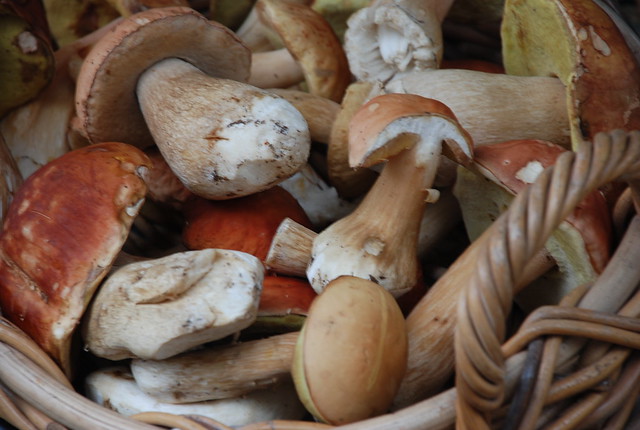 |
| Porcini mushrooms for sale. Photo by Kristen Taylor (Creative Commons license, link) |
So, how could this happen, and how common is this? We have described a lot of species on Earth, especially among plants. But there are some organismal groups that are large uncharted areas on our biodiversity maps where not much is known, and fungi, bacteria, and insects are among those groups. If you are looking for a career focused on new species descriptions, I recommend those groups, and maybe also other invertebrate groups and smaller algae. There is a lot to find out!
Dentinger and Suz explain fungal discoveries:
"Although taxonomists regard new fungal taxa as commonplace, they are often of little apparent consequence to human society and largely go unnoticed by the public. Like all groups of organisms, our knowledge of fungal diversity is biased towards taxa of greatest concern to ourselves, such as edible fungi. For example, wild mushrooms collected and sold as food around the world generally belong to a handful of well-known taxa (e.g., truffles and chanterelles), most of which have long histories of use in European cuisine. However, even some of these well-known groups have been shown to contain underappreciated levels of diversity. "How did the researchers figure out that the package of Chinese porcini a friend of theirs had bought in London and brought to them as a dinner item had new species in it? Porcini belong to the Boletus genus, which include some incredibly delicious species, as well as some you definitely should not eat. I assume they got curious about the brown fungal bits in the bag, and decided to check it out. They took their samples to their molecular phylogenetics lab, extracted the DNA from individual pieces, and then compared those DNA sequences with all known porcini mushrooms' DNA. It turned out that the DNA sequences were different enough to warrant the first description of three new species from China. These new porcini species were named after Chinese common words: Boletus bainiugan, Boletus meiweiniuganjun, and Boletus shiyong (link to description article here).
Can the same thing happen when you buy a bag of dried food plants? Yes, it could, but it is probably less likely because we know more about the plant species of the world.
Reference: Dentinger and Suz (2014), What’s for dinner? Undescribed species of porcini in a commercial packet. PeerJ 2:e570; DOI 10.7717/peerj.570
PS. So, truth to be told, fungi are not actually plants, but fungi have historically been included in botany since they also are sessile organisms stuck in the ground on land (usually, but not always). In reality fungi are actually more close evolutionary speaking to animals than to plants. So, mushrooms are more closely related to bacon, than to potatoes and bamboo shoots. Vegetarians might want to consider that. :)
Thanks to our blog reader EC for sending me the link to this interesting paper.
